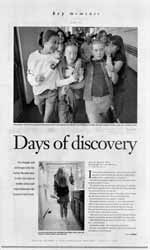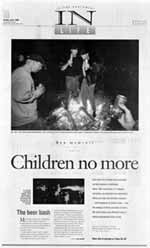Fall 2000
Mapping Key Moments in Young Lives
By Pat Ford
Pew Center
There was Jody, a drug-addicted, teenage runaway. There was David, a 9-year-old tormented by the effects of fetal alcohol syndrome. There were Micke and Jonn, childhood friends who grew apart as one drifted to sports and the other to jail.
Reporter Jeanette White found these dramatic subjects to illustrate The Spokesman-Review project “Key Moments,” an exploration of the critical times in a child’s development that can make the difference between a future of success or failure; happiness or misery.
Yet, of all the poignant stories she and her colleague Rebecca Nappi told in the course of the 10-part series, none stirred readers like the tale of a perfectly unexceptional seventh grader whom White had followed through her first year of middle school.

Thirteen-year-old Ashley Muzatko faced the same challenges, had the same successes and made the same mistakes that many American adolescents do. Her distinction was her unstinting candor in allowing White and photographer Colin Mulvany to document them. The story – part four of the series – unleashed a torrent of angry letters.
Typical was this one: “As the mother of a seventh grader, I was appalled… I would be sickened if my daughter were to be plastered all over the papers, kissing and making out, not to mention having her belly button pierced… .”
The Spokesman-Review printed just a few of the letters but Managing Editor Scott Sines felt compelled to defend Ashley and her parents in a column that sums up the importance of the “Key Moments” series:
“…these people understand that by sharing their experiences during those difficult times, they are helping other people in the same situation. And, by using the newspaper as a mirror to reflect what happens in homes, churches and schools, we get to know our community better.”
“Key Moments” grew out of community response to an earlier series the paper did on Spokane’s burgeoning population of prison inmates and former inmates returning to the community.
“Readers were just appalled,” says Nappi, an interactive editor at The Spokesman-Review. “They said, instead of imprisoning people, where can we intervene to keep them from turning to crime? Can you as a paper help us figure it out?”
It was a tall order. But the paper agreed it was a vital story.
Doug Floyd, also an interactive editor, convened four focus groups of people who work with children: educators, scout leaders, police officers, juvenile court judges, child welfare workers, psychologists, counselors and others. He asked them simply to discuss behaviors and circumstances that they see in kids’ lives that give them some strong indication of what to expect from them later in life.
“We weren’t trying to pin them down to a list of 10 things,” says Floyd. “We just asked for things they look for. The things we pulled together and called ‘key moments’ were just the things that came up frequently. Some things came up time and times again. Junior high school, for example. That first year of junior high came up time and again.”
Initially, the paper developed a list of 20 key moments but consolidated several and eliminated some to keep the series a manageable length. The key moments fell into two categories: chronological and developmental. In the first category are conception to birth; bonding in infancy; age 10 (fourth grade); the first day of seventh grade; and rites of passage – drinking, driving, sex – in the teenage years.

Developmental markers were affiliations, such as friendships and school groups; major moves that influence a sense of rootlessness or connectedness; times of loss, such as divorce or death; first failures and first successes; and values development.
It was left largely to reporter White to find the human faces that exemplified these moments. After the series’ other lead reporter left the paper, White ended up writing seven of the 10 parts. Nappi wrote three, two of which she handled interactively, letting fourth graders tell their own stories and going to adult members of the community for first-person reflections on their first successes and failures.
For White, finding the subject was often a painstaking process; following them was equally challenging.
The homeless teenager Jody West, who epitomized the feeling of rootlessness, moved around so much that White and photographer Mulvany would lose track of her, sometimes for months at a time. White worried that Jonn – the high school athlete whose childhood friend went to jail – might drop out of school or do something else catastrophic.
“You have to let it play out,” White says. “You can’t have preconceived notions of how these stories are going to go. It’s hard to relax and do that but you have to be flexible and adjust.”
In addition to the intimate portraits of people living these key moments, each installment of the series featured an overview story and sidebars and boxes with lists of suggested reading material, community resources for help during these critical moments, and tips for getting through them.
The Pew Center supported the project, intrigued by the paper’s plan to use civic mapping techniques to plot the key moments. Civic mapping is a method normally used for identifying informal sources at deeper levels of community life. The Spokesman-Review, though, drew up a map that was, according to Floyd, “not geographical but sociological.”
Floyd says he and other editors surveyed nearly 75 teenagers – from the youth representatives in local government to inmates in the juvenile detention center. They asked the young people to evaluate their own experiences in these key moments on a scale of 1 to 10, 10 being an “ideal world” for successful adulthood.
Then, they asked why the teens fell short of the ideal, where they had turned for help at those moments – be it grandparents, parents, professionals, peers or community groups – and whether they’d received the help that they had sought. The editors then plotted the answers on a grid to discern patterns and used the results to write the sidebars about resources and tips.
Reader response varied by installment. While Muzatko’s story brought in a big response – much of it negative – other stories inspired less vehement but more positive mail. Nappi said she was surprised, however, by the reader who complained of opening her paper to “scribbling from brats” after the installment written by fourth graders.
Overall, reporters and editors say they feel the series has been favorably received. Nappi’s niece saw the segment about bonding in early infancy stuck to the refrigerator of a pregnant friend. White got a request for a copy of the series from a mother who said her non-newspaper-reading daughter was drawn into one segment and wanted to read the whole thing.
Floyd held two community forums after the series ran. At both forums, Floyd says, the paper was able to connect parents who needed help with specialists in the community who could provide it.
Nappi is pleased that the series tackled what she referred to as “the mushy middle,” a large subject that doesn’t easily lend itself to traditional news coverage.
“The public really got it,” she says. “This is where we live; this is what we talk about. It was really the culmination of a lot of projects that have come before it. We wouldn’t have been able to do it without those earlier ones.”
You can read the entire series on the paper’s web site, www.spokane.net.
